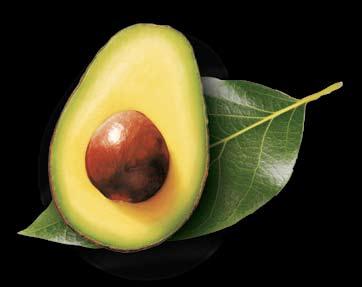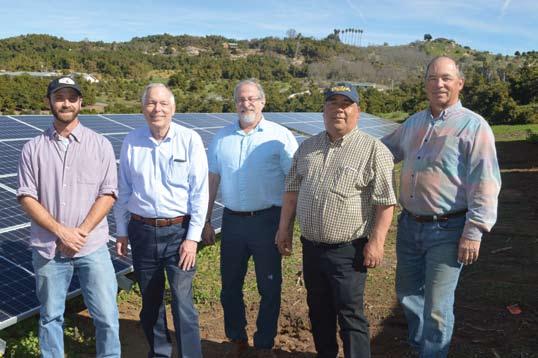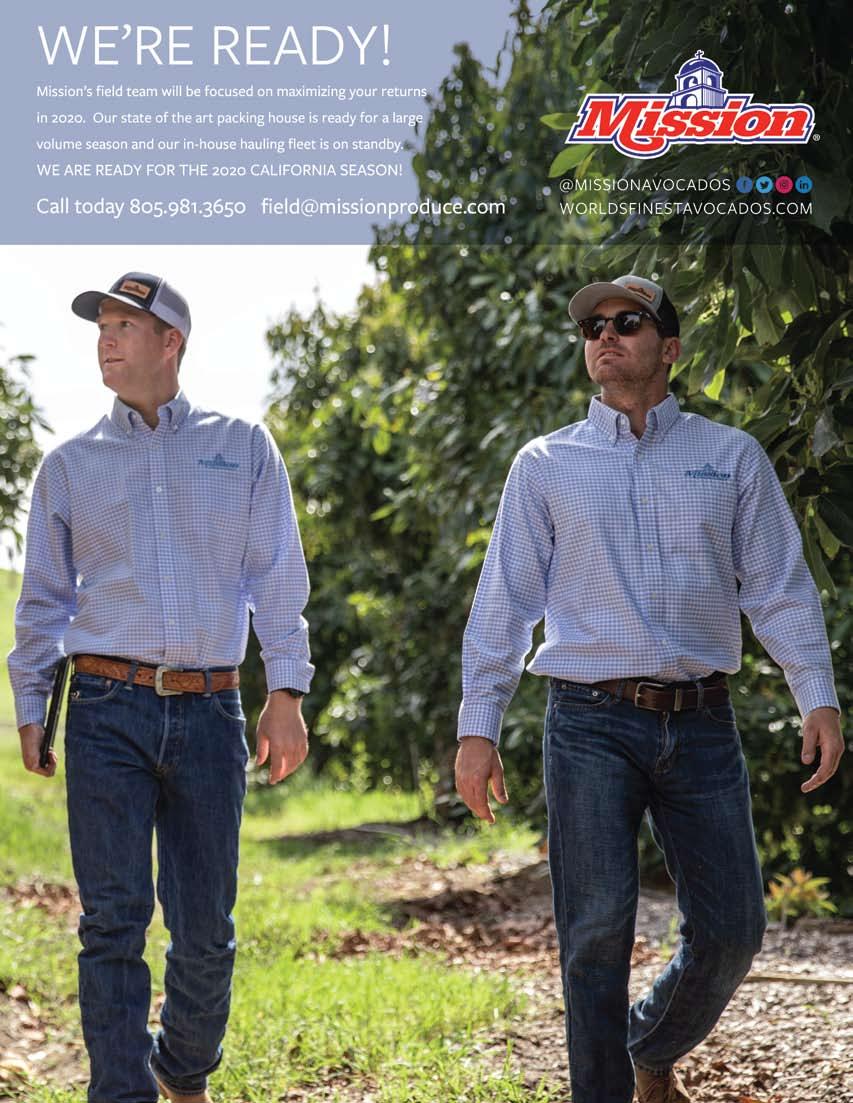
9 minute read
From Musician to Physician to Grower –Norman Kachuck’s Circuitus Journey
Grower Profile
From Musician to Physician to Grower –Norm Kachuck’s Not-So-Linear Journey
Advertisement
By Tim Linden N orm Kachuck has approached his current career as an avocado grower with both a scientific and an artistic perspective, which is fitting considering his previous work in the music and medical fields. His artistic appetite was the first he fed as Kachuck headed to UCSD in the early 1970s to study music after high school. He earned a degree in musical composition, played keyboards in the Los Angeles area, toured the country with various bands and did graduate work at the prestigious music conservatory in New York City, The Julliard School.
By now, the ‘70s were coming to a close and the scientific side of Kachuck’s personality asked for equal time. He headed back to California did post-graduate work at UCLA and then entered USC’s Keck School of Medicine, doing his neurology residency and fellowship there as well. That took care of the ‘80s. “I joined the USC faculty in 1991, and during my 20- year tenure there served as clinical chief of the neuroimmunology division, and founded and headed the Multiple Sclerosis Comprehensive Care and Research Center.”
He served USC in many different capacities in those years as well as serving as a principal investigator in dozens of multicenter studies on multiple sclerosis (MS). Kachuck published 35 papers, wrote six book chapters, and lectured worldwide on MS, as well as on ethical issues in medical practice and clinical research, the philosophy and psychology of medicine, and the evolutionary neuroscience of consciousness. In 2010, he left USC to help his father run the family business of growing avocados in Valley Center, CA. “It became obvious that my dad needed help,” Kachuck said, adding that the first signs of dementia appeared in 2008. “I had a moment of reprioritizing and epiphany and knew I had to do this to steward this marvelous legacy for the family.”
He transitioned away from USC clinical practice and research as quickly as he could, which he admits was not that easy. “Actually, it was horrible. It took about a year and half,” he said, noting that he had a full slate of patients who he had developed relationships with for many years, and they relied on him.
Over the years, he has kept a foot in the medical arena, serving as medical director for Kepler Diagnostics, which is developing ways to identify and validate the use of serum biomarkers in MS decision-making.
But his main pursuit for this past decade has been running Kachuck Enterprises, the avocado growing operation founded by his father, Israel Kachuck. The company’s founder grew up in Brooklyn, joined the Navy, received a degree in electrical engineering from NYU and married Rhoda Silver, a scholar of English and American literature. In 1960, the couple and their two sons moved to Southern California, where he worked in electronics, including as chief engineer for the ground support electronics of the Stage II booster of the NASA Apollo Project.
But like his son who would follow his lead, Israel was not
content with one career. He received a master’s in business administration from UCLA in 1968, left the engineering field and entered the world of real estate development. Kachuck Enterprises was incorporated and built three furniture stores and two chain restaurants. In 1969, the company purchased 110 acres of land in north Escondido with the goal of creating a residential development. Kaywood Forest was built and sold, through the mid-1970s into the early ‘80s, featuring 65 houses, based on three designs created by Israel.
The acreage also included an avocado orchard that was managed by Henry Avocado. In discussions with avocado experts Gil and Warren Henry, Israel believed investments in avocado ranching offered a great opportunity. He liked the tax breaks associated with farming and thought avocados had a bright future as a profitable enterprise.
According to Norm, his father also believed that some of the traditional ideas about optimal growing techniques could be improved upon. He advocated for using lower cost hilly land, decreasing acreage density and encouraging lateral growth. Israel Kachuck joined with the Henrys and others in purchasing 460 contiguous acres in the Valley Center region, called the Double Canyon property as it is on the road of the same name. The hilly acreage was bought at a bargain price and the development into avocado groves began in the early ‘70s. Today the majority of the acreage is farmed under the umbrella organization called Avocado Corporation of America (ACA). The acreage was originally split into separate ranches with the ownership of these various ranches changing several times over the years – they are now six in number, three owned by the Kachucks, and others by partnerships for which they are general manager. What hasn’t changed is the business management of the farming operations by Kachuck Enterprises with the CEO being Norman Kachuck, and the packing and selling of the fruit by Henry Avocado Corp. under the current direction of Phil Henry, president of that company.
What also hasn’t changed is the site supervisor and foreman, Serafin Michel. He has been on the property since the different ranches were first planted almost 50 years ago. Serafin was hired as an irrigator by his uncle Ramon in 1973 at the age of 18. “These are my babies,” he says of the 18,000 trees spread over about 400 acres currently managed under the ACA umbrella. “I’d say I personally planted about 60 percent of these trees.”
And while he hasn’t named each tree, he knows them very well. He and Kachuck agree that Serafin can walk through the groves and recall the production results of most sections, if not individual trees.
Kachuck said Serafin has been key to virtually every important decision since he took over. “I hear voices – Serafin mostly – when it comes to making decisions about every aspect of the grove,” Norm quipped.
Kachuck liberally uses science to aid in the decision making. Every three months, their agronomist takes soil and leaf samples and Kachuck comes to this interview armed with a briefcase full of production information and other pertinent papers chronicling the life of the groves.
Serafin and Kachuck acknowledge that their tree per acre ratio of about 50 to 1 is much less dense than most groves and flies in the face of the current trend to have more trees on each acre growing to a smaller height to facilitate easier picking. The ACA acreage utilizes large lateral growth and limb supports, which Serafin said was pioneered at this ranch. “Other growers use that technique,” he said, “but they copied us.”
As the veteran pair talk about the trees with their majestic height and limb-supported lateral growth, they clearly paint an artist’s picture of their groves. They have not been designed to maximize space with cookie cutter trees but rather to encourage free-flowing sprawl, with each limb maximizing its own capabilities. Serafin believes encouraging the lateral Connor McClelland, Phil Henry, Norm Kachuck, Serafin Michel and Larry Slominski pose in front of the new solar installation at ACA ranches.

of its water needs.
In addition, this past year Kachuck Enterprises worked with 40-year solar industry veteran Slominski to convert its electrical sourcing from San Diego Gas and Electric to a solar installation. Removing some low yielding trees uncovered three-fourths of an acre for the 472-panel solar development. The yield of about 875 kilowatts is expected to handle the groves’ annual power needs. Slominski said the panels are made by Hyundai, as he wanted to buy panels from a company that was sure to outlast the life of the panels. He said panel efficiency has improved exponentially since he got into the business decades ago, allowing the installation to pencil out engineering-wise as well as economically. Kachuck revealed that the biggest financial issue was the upfront cost of such a large system. However, that is being defrayed by generous state tax credits and depreciation allowances, and the recouping of the out-of-pocket cost is estimated to take about 2 ½ years for a system that should last about 25 years.
Toward the future, Kachuck is exploring other technologies for their efficiencies, and is hopeful that the recent sequencing of the avocado genome, and advances in understanding plant immunology and the mechanisms of disease resistance, will improve care practices, productivity and economic success. And he emphasizes the need for an immigration policy that allows farmworkers to safely and successfully come to help work the land. Mostly, he notes, “the success of our operation depends on the people who care for the land, the trees, the fruit, and most importantly, each other. And that is the bottom line of our business plan.” growth is superior and more efficient than planting new trees and having to wait several years for production.
Kachuck says the ACA grove structure has resulted in “a wonderfully robust 14,500 pounds per acre per year harvest size average since 2012. We believe that reduced competition between trees results in concentrated and optimized root growth and nutrient delivery, water retention, fertilizing and pest control, pollination, tree access for maintenance and harvesting, and sun exposure with wind protection.”
Serafin and his crew try to keep the tree heights limited to 30 feet, and stump about 350 trees annually to re-establish productivity. In addition, they replace a couple of hundred dying or underperforming trees each year.
The duo also credits the geography for some of the great results they have achieved. “Geographically, it is in the main microenvironment defined by the north-south Double Canyon,” wrote Kachuck in explaining the advantage. “Over the years, this location, while complex in terms of terrain, soil types, and wind and temperature exposure, has turned out to be wonderfully protective of the trees and their fruit. As avocado agronomy has been better understood, it turns out that the decision to plant this area was prescient in optimizing how the trees manage water, nutrients, salt and temperature.”
While there is a high salinity in the soil, Kachuck has hypothesized that the high concentration of zinc, magnesium and other elements has lessened the negative impact that salt usually has on avocado trees and their fruit. He notes that the science involved in avocado production and tree health is not that dissimilar to the immunology research he performed in trying to understand human diseases and potential cures.
Kachuck said when his father was running the operation, he did so more as a one-man show. Norm takes a team approach, which was evident on this day as he brought his packer Phil Henry, solar engineer Larry Slominski of LTS Solar Energy, agronomist Connor McClelland of San Diego Ag Lab, and grove manager Serafin Michel to the interview and photo shoot. Team member Jim Davis, the entomologist, was not available.
Through good and bad years, Norm Kachuck said the ranch has proved his father accurate when he projected that the crop had a bright future. However, he is aware of the challenges that all growers are facing including water quality and price, labor availability and retention, pests and pesticide safety, and technology innovations for grove monitoring.
ACA is determined to be on the cutting edge of new technology and to continue to address these issues. With the help of cost-sharing programs sponsored by the Farm Services Agency, the local Mission Resource Conservation District, and work by the Stehly Brothers Drillling, the company has looked into moisture sensing technologies, and recently tapped and connected to two additional wells to help take care The new solar installation on the ranch is expected to yield 875 kilowatts annually.












